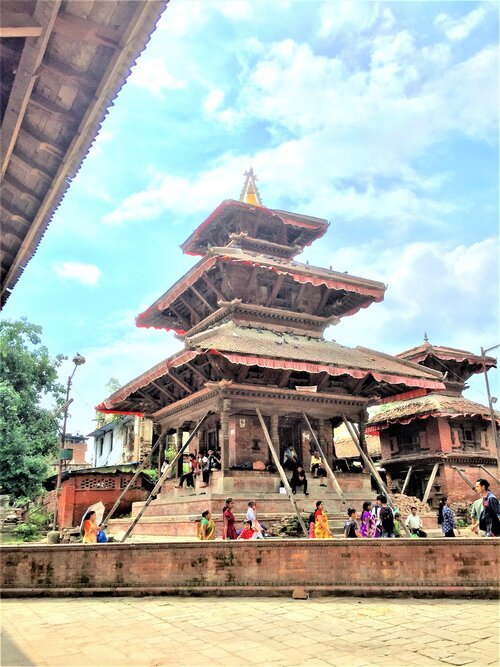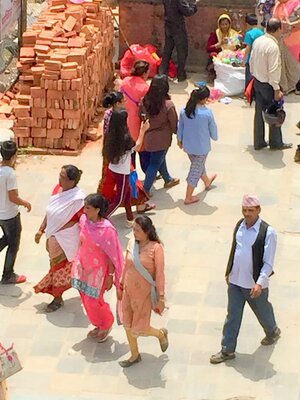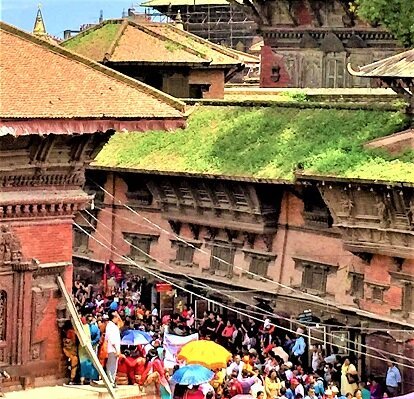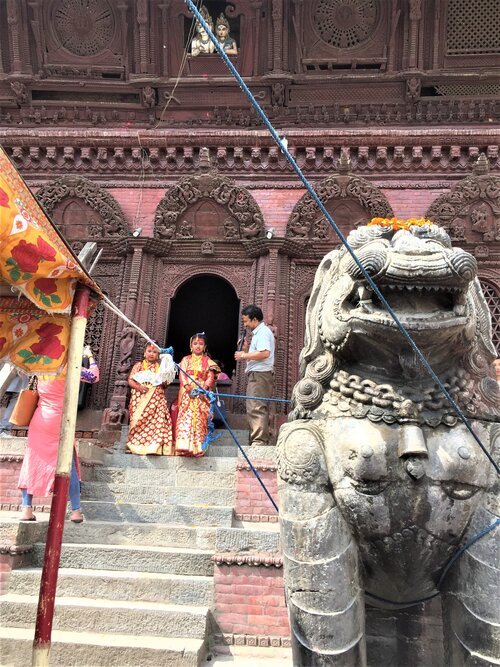vaga #6/4 Namaste Thamel
PART IV
DURBAR SQUARE
Durbar Square, a UNESCO World Heritage Site, It is located in a corner of Thamel, that was formerly the royal palace since 1069 and is under reconstruction, I imagine when it is finished it will be a wonder and even better than before because the wood is being renovated, and old walls are being improved. There are many temples and places of prayer, it would take several days to absorb everything with their stories and on the other hand you can not access several parts because of the reconstruction. There is a building with classical French architecture in between that I did not photograph because it had nothing to do with it and was made at the beginning of the last century by a king to catch up with the French or something, it was absolutely out of place and annoying the Nepalese landscape at its best.
I always suggest reading the blog on a computer, the photographs are designed for your best appreciation.
the access to the square is always very busy, some streets more than others, a lot of commerce, and it is an important part of Kathmandu's routine, bustling, with its own energy.
The large square with temples built at random, there is no order of urbanism, since each king was doing his own thing. Pedestrian traffic from one side of Thamel to the other, no cars or motorcycles cross through it. They are seen inside in their harmonious disorder, between the different temples, palaces and altars to the ascetics sitting waiting for some donations, they do not like to have their photos taken, they make gestures with their hands so that you leave, trade for tourists with souvenirs, sales of incense, candles and flowers for the parishioners. Among the rubble the faithful make their prayers, nap, rest, eat, it is a meeting point, architecture students sketch the temples, children play, cows are welcome, centre of festivities, all under admirable respect. Tourists add to this picture taking photos, as the last photo turns out to be Peter (December 2018), there is also a family album here, since I don't have another parallel journal. A living square.
A RANDOM DAY
in another corner of Thamel, there is a fair-type street trade for Nepalese, approaching the fair with Rafael (July 2018) we began to see women with red sarees, well-dressed, the streets were decorated with bright strips from side to side, a lot of agitation, in an open space between markets of fruits, vegetables, electronics, clothes ......
We entered the street filled with decorations, we saw women with elegant red sarees in an attitude of waiting, surrounded by vendors, shops with their products on the street, wonderful fabrics, and sarees in particular. Then there were other younger mothers sitting in line on the pavements with their daughter or daughters all dressed in red. These girls, between 3 and 5 years old, dressed in red, were very made up, with jewellery, and the famous bracelets that I have already talked about, but I noticed since I learned, they were elegant combinations, only gold with reds. They also had their hands decorated with drawings made from of henna. They waited, and I had no idea what for, curiosity corroded me inside.
We continued to push through the crowd there was a Hindu "priest" (layman) praying, people praying and giving offerings, he only had yellow strips to demarcate his place and people did not pass over him. Since Raphael had only a while to get to know the square we continued walking to the square and visited the royal palace. The street continued with its rhythm every day around the festivity, immutable to everything. They sell flowers, orange flowers are the ones that are bought the most for offerings, they are called "Marigolds", and food. In the last photo you can see a part of Raphael's face and the frame of his glasses, my children don’t like having their photos taken by anyone, so I go paparazzi on them.
after a while the entrance of the square through the street of decorations is filled to its maximum capacity, people from side to side who advanced slowly in procession towards the square
Since Rafael had only a while to get to know the square we continued walking until we reached it and visited the royal palace. On the other side of the square there was a tent or Hindu awning, very nice. Below in semicircles were families sitting. Young parents in street clothes and very elegant women and all in red. They had their daughters sitting in front of their feet. The girls looked between 11 and 13 years old, very elegant with red and gold sarees which were more complex than those of their mothers. And on the ground offerings, many offerings of food, incense, holy water, bronze wells, and you see that they were more sophisticated than those used daily. A man spoke into the microphone for a long time. Even with a lot of smog and my dirty cell phone camera, because these photos would have been "great photos", anyway, I cared more about absorbing what I saw, trying to understand what was happening, feeling that energy that was powerful. The hallucinating colours, red colour party.
We stayed for a while and there wasn't much more action other than the speaker. We continued walking, we went to the palace and before leaving we saw the girls walking outside a temple, the photos describe it well, they go with their mothers. And the fathers take pictures from below. It was chaos to take pictures, among the tent, the rubble, the parents and families photographing. They passed through a door, blessed themselves, and kept walking. What was through that door impossible to know, I imagine a deity. Above the door are two sculptures of the king and queen watching. It will have been about 20 girls. The truth is that I would not have missed a minute of the whole festivity, but Rafael had to keep walking to finish seeing more of Thamel since we were leaving for the south the next day. .
Just writing this chapter I started to find out what holiday it was, my Nepalese friend Gopal, informed me and gave me a link where to find out more. The festival is called, "Bel-Bibaha", from the "Newar" community, they are from the Kathmandu Valley, where their most notable ceremony is that of Kathmandu. Newari girls must marry three times in their lives. The first marries Lord Natayan with "bel". This is what I read, everything is very confusing, complex, gods, etc. but something I could rescue. The belief says that it would help prosperity and fertility and when she is widowed she will never be a widow because she will remain married to the god Bishnu who is immortal. This ritual gives you the right to remarry in case of divorce, which would be unthinkable in Hindu society in India. The "Newari" culture has always advocated for women's rights. The ceremony lasts two days, with purification and prayers it is too entangled to relate, and on another occasion they marry "Barha" who would be the "Sun" and the third time she marries her husband.
THE PALACE
The palace was under construction, you can enter through designated places between scaffolding, piles of bricks, men with wheelbarrows, the truth is that in Western countries they would never let you enter those conditions with so few safety precautions. An entrance fee is charged, and those funds are needed. There is a rather amazing museum inside about the reconstruction, it’s very well assembled, an oasis to the chaos of the outside. Well lit, nice graphics. Photos of the ruined temples of the earthquake, many drawings of the temples to be rebuilt, models of each of the temples, pieces of lintels with their carvings, ceramics, among other things. In the reconstruction program, several universities in Europe and the United States are incorporated, such as anthropologists, historians, architects. It feels like an absolutely professional top-of-the-line job. Everything is apparently financed by China, it was full of signs of the agreement, China-Nepal and the reconstruction of the square. The palace has a refined architecture, of bricks and wood, all beautifully carved, with great mastery, an admirable beauty, one because there were too many, the pillars from top to bottom, lintels, balconies, not an inch without carvings. You can see the museum where you are left with an idea of what it is like, because you can not see much more since most of it is closed, the seven gardens and the many water fountains, the pavilion of the concubines etc ....
The carvers there in the field doing their own thing, what a good thing that the architecture and the crafts are respected, not all the reconstructions of temples and palaces are respected since it is a tremendous job to carve each pillar, it is cheaper, and faster to put a smooth pillar or a simple carving, to say the least.
The construction does not have a single nail
KUMARI
A unique curiosity is that there is a palace on one side called "Kumari Ghar". A square building of about 60 meters and inside a small courtyard where the windows of the palace go up two stories high, this is all in wood. "Kumari is the living goddess." Formerly in the Kumari language it meant "pure innocent, virgin or single girl", in Nepali language, Kumari came to mean 'virgin girl'. There are three Kumari girls -the one from Kathmandu, Lalitpur and Bhsktaptr-, they must belong to the ethnic group or community "Newa" (the same community of the festival just narrated in the previous photos) and of the Shakya caste and at the time of being elected, they must be between two and four years old, being that of Kathmandu the "royal goddess". In addition, they must meet a number of requirements, such as having a certain astrological chart or a clear voice. According to tradition, they are the reincarnation of the Hindu goddess Kali in the Taleju temple and their mandate extends until the first menstruation arrives, and they must leave the temple and cease to be goddesses. The Kumari is revered and idolised by some of the country's Hindus, as well as by Nepalese Buddhists (one of the many contradictions of 'popular' Buddhism), but not by Tibetan Buddhists.
The current Royal Kumari, her name is Trishna Shakya, was elected on September 28, 2017 at the age of three and became a goddess on September 24, 2018. Succeeding her predecessor, who retired at the age of 12 when she reached her first menstruation. The girl Trishna Shakya was carried among a cloud of photographers and in their arms. At the same time as the outgoing Kumari, she was dismissed with a tribute from the army and taken in a float escorted by hundreds of people to the home she left almost a decade ago to become a child goddess and with state honours.
From what I heard the girl returns with her family to her village, without a single rupee. The family and their relatives lived in luxury and had servants for years only to be thrown out. Many are very upset, it ends badly, although they can then study, marry and lead a normal life, but without privileges. However, for the family it is a pride, yet the girl is confined for 9 years with sporadic outings abroad on religious holidays. The girl goddesses receive education in the compound where they are held, where they even carry out official examinations, and can receive the daily visit from their parents. She peeks out of a second-floor window that looks out of the inner courtyard once a day, at 4 p.m. Nepalese come from all over the country to see her, and it is a tourist attraction we are allowed to be present. I never managed to see her, but when I was in the courtyard you could see through the wooden trellises of the windows a pile of stuffed animals.
An anecdote, a nine-year-old girl, Sajani Shakya would be dispossessed of her divinity by the Nepalese government, more precisely by the supreme court of Nepal, for having travelled to the United States for a month and without authorisation, an unusual case in the 700 years of history of the Kumari goddesses. Leaving their temple of worship without permission is considered in Nepal as a sacrilegious act, since the Kumari cannot be touched by anyone and are only fed through a ritual meal called "pure".
Cultures and cultures looked at by my Western eyes are incomprehensible, like so many of those I have seen. It is difficult not to think, to rationalise, not to understand them, to make an effort to respect them without judgment, that is an exercise that I have developed over the years. I have found myself again and again at the crossroads, my judgment versus cultures or rites incomprehensible and that are maintained in these times of computers with access to all the people of the world, children, adolescents, young people have them as part of their lives, where the borders and transfer of information take for thousandths of a second, and so I commented in the previous chapter, Google contributes with the translation of more than 100 languages. I have drafts of these issues and how to understand that in the twenty-first century, it remains the same, the more they will continue like this, or they cling more so as not to lose them, is it good, is it bad? . Someday I will shape those writings that are so far full of personal contradictions. Because readers who have not lived and shared closely with these cultures, and families it is very easy for them to have an opinion of being absurd, retrograde, limiting, what mine was like. But this has changed in me, and I'm sure I'll never understand them, but there is something behind it, and it's what I see in people, in the intentions that leave me with a concern that I must delve deeper into the subject. Some are more bearable, approachable, more understandable, but others absolutely incomprehensible like the Kumari.
the photos below I just took from the internet on the page of the PUBLICATION EFE, I think they are important to the story. Seeing her palace and knowing about her existence was curious, but seeing just these photos that I downloaded for the blog, they make me uncomfortable seeing the little girl in person and at that age. It is the culture and I show it as such.
the photos above I just took from the internet on the page of the PUBLICATION EFE, I think they are important to the story. Seeing her palace and knowing about her existence was curious, but seeing just these photos that I downloaded for the blog, they make me uncomfortable seeing the little girl in person and at that age. It is the culture and I show it as such.
































































































